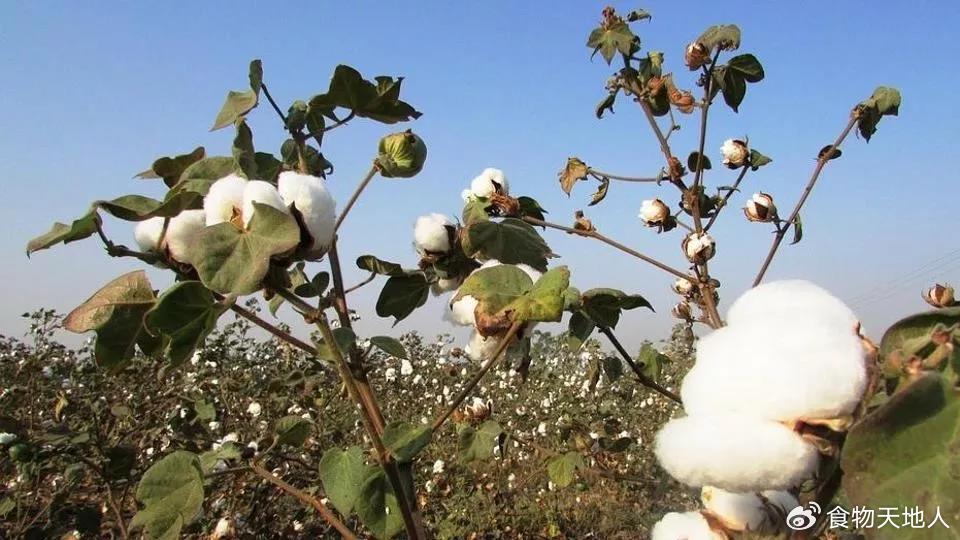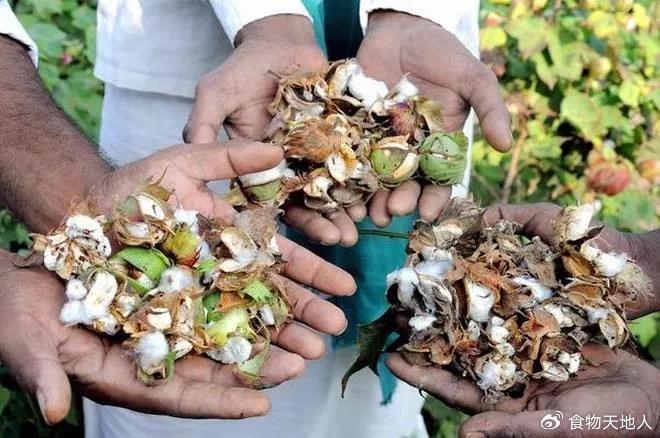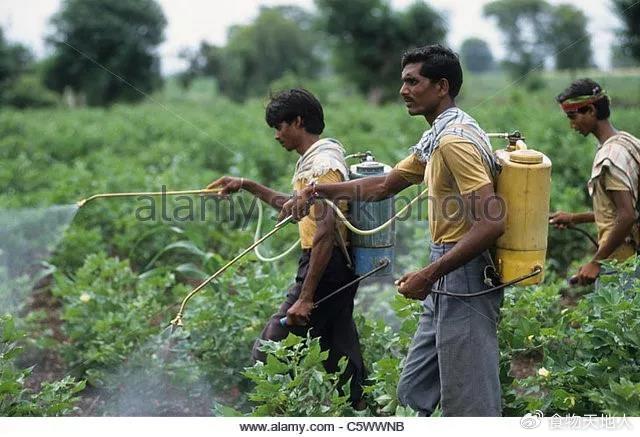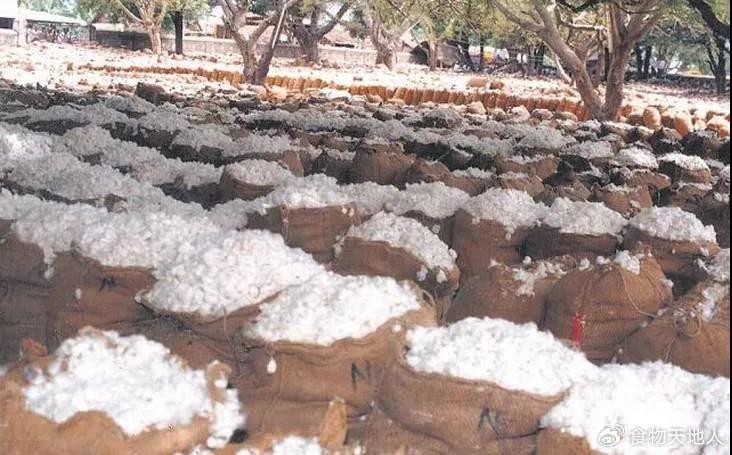转基因棉花在印度仅仅风光了四年
导语
印度是世界上第一大棉花生产国,也是第二大棉花出口国。转基因棉花在上世纪90年代引进印度,而孟山都从2002年开始推广商业种植。2018年英国土壤协会的调研报告追踪了转基因棉花在印度的由盛而衰,发现其实它只风光了短短四年,而且存在以下问题:
首先,在2006年,印度西部地区的棉红铃虫就出现抗药性,这是因为转基因棉会持续释放毒素。在长期有毒素的环境中,那些本身对毒素有遗传性抗药性的害虫得以存活。近年来杀虫剂的用量已经从2006的每公顷0.5kg增加到2015年的1.20kg。
其次,转基因棉花的增产只发生在02-05年。从2008年-2012年,虽然转基因棉花的种植比例从67%上升到92%,但是单产却逐步下降。
最后,由于转基因棉花种子价格高昂,再加上肥料以及农药等其他投入,棉花的种植成本增加了三倍。这导致2006-2011年间,仅在马哈拉施特拉邦的一个地区就有7992名棉民自杀。
英国土壤协会成立于1946年,创办人为农民、科学家、医生和营养师。协会的宗旨是改善土壤健康、食物、动物、人类和环境之间的联系。土壤协会现在已经成为英国首屈一指的会员制慈善组织和认证主体,为食物、种植、健康、美容、时尚、纺织品和森林多领域的生态产品倡议。

生物技术产业的支持者长期以来一直宣称,转基因作物将解决一系列难题,为世界提供食物,消除发展中国家的贫困,提高作物产量。而事实上,这项技术一直未能兑现承诺,反而让世界上一些最贫困的人口为这个行业的炒作付出了沉重的代价。
印度是世界上第一大棉花生产国,也是第二大棉花输出国。这篇报道探讨了转基因棉花在印度轰轰烈烈的兴起以及毁灭性衰落的过程。1
一、印度转基因的情况
2002年,马海可孟山都生物科技(印度)有限公司(MMBL)首次将转基因棉花引进印度。该公司是由马海可种子公司(Mahyco Seeds) 和孟山都印度公司的合资企业。该公司将转基因技术转让给49家印度种子公司。2 凭着声势浩大的广告宣传活动,包括邀请跳舞女孩和明星代言,转基因很快便成了印度棉花生产的主力军。3时至今日,印度1180万公顷的棉花中有90%左右都是转基因的。4
这种市场垄断对非转基因棉和有机棉形成了很大威胁,使农民越来越难买到当地的非转基因种子,因此不但减少了他们的选择,也威胁到了国家的种子主权。
“纺织交流"组织(Textile Exchange)是一个致力于提高纺织业可持续发展能力的全球性非盈利组织。2012年,它呼吁组织了一个多方圆桌会议,试图解决农民面临的非转基因棉种供应特别是有机棉种供应稀缺的问题。当时,转基因被认为是该国和其他国家有机棉可持续发展未来面临的最大威胁之一。
然而,仅仅五年之后,事情就发生了变化。正如本报告所显示的那样,转基因被推到了风口浪尖,事实证明,这一行业的虚假承诺给印度农民带来了一场灾难。转基因看来要从这个国家迅速消失了,消失的速度几乎和来的时候一样快。
二、什么是转基因棉花?
由孟山都公司开发的转基因棉花通常被称为Bt棉花,是通过将一种或多种来自苏云金芽孢杆菌(Bt)菌株的一种或多种基因插入到棉种中而形成的。Bt是一种会产生毒素的杀虫剂。5 由于植物的每个部分被改造来产生毒素、防御昆虫攻击,所以基本上,防虫不是靠打药,因为植物本身就变成了杀虫剂。在美国,Bt棉花本身就被注册为杀虫剂。6

作物能产生Bt毒素的这一概念当然是创新性的,但不幸的是,在现实使用中,Bt的抗虫性无法长期持续下去。这其中有各种原因,生态科学的基本原理已预测和解释了现在转基因棉花出现的诸多问题。这些问题往往会造成悲惨的后果。其中一些在本文有所强调。
三、第一个缺陷——害虫的抗性
2006年,也就是孟山都公司投放以抗棉红铃虫为主的第一代转基因棉花Bolgard I的四年后,7 印度西部四个州的棉红铃虫就产生了抵药性。8 孟山都公司对此做出的回应是推出更昂贵的第二代Bt棉花Bolgard Ⅱ,9 其中含有两种(而不是一种)转基因性状。但在几年之内,红色棉铃虫对此又产生了抗药性。10 由此看来,通过转入多个基因来解决抗药性的做法是有问题的,正如实验室试验所预测及证明的那样,害虫耐药性的进化速度是非常快的。11

Bt棉花的植株被人为地设计来持续释放毒素,显然是害虫耐药性迅速提升的一个关键原因,因为长时间暴露在毒性环境中,只有对此有耐受基因的害虫才能存活。正如有关科学家联盟的一份报告所述:“经过一代又一代发展,耐药个体在害虫种群中的比例可能会增加,从而降低了Bt作为杀虫剂的功效。”12 13
随着害虫的耐药性开始增加,农民已不能仅仅依靠转基因棉花,他们也需要使用常规农药来保护农作物。近年来,种棉花使用的杀虫剂在逐年攀升,从2006年的每公顷0.5kg到2015年的每公顷1.20kg。14

如果在棉田中加入“隔离带”(种植非转基因品种),那虫害的耐药性就会减少。但是由于成本上升、单产下降,农民面临巨大的经济压力,因而会尽量利用一切可利用的土地来耕种,所以在实际生活中这种情况很少出现。
2016年初,总部在卡纳塔克邦的农民组织的KRRS召开了一个邦级会议,向该邦政府施压,要求种子公司赔偿该邦几个地区的棉花作物由于棉红铃虫害造成的损失。15 阿克萨拉•克里希基金会是一个非盈利组织,它在一份报告中发现,赖尔久县15万英亩的棉田中有80%欠收,给农民造成了2.7872亿卢比的巨额损失(约为416万美元)。16 17
有人批评政府和科研机构刻意报低棉农的损失,他们指责,“农业科学家试图要捍卫农业企业的利益。”18
具有讽刺意味的是,在转基因棉引进之前,棉红铃虫的数量少到可以忽略不计,但现在却是造成巨大损失的主要原因。19
为了防止棉红铃虫在下一季度继续为祸,不仅是农民毁掉了受虫害侵袭的转基因作物,连农业部也采取行动对受害棉田进行消毒工作。20
农民们递交了对种子公司的投诉信,并要求刑事立案,及着手调查。种子公司的宣传册和种子包装袋上都声称,作物在整个生长周期内都将免受美洲棉铃虫、翠纹金刚钻、棉红铃虫以及灰翅夜蛾和棉小造桥虫的侵害,但显然这些公司未能兑现承诺。21
四、其他问题 ——次生虫害
大自然不容忍真空环境,因而当一种害虫被消灭时,另一种就会取而代之——这被称为害虫取代。22 当转基因技术还在发挥作用并成功地减少棉红铃虫的数量时,其他害虫就会乘虚而入,所以农作物随即受到粉虱、叶蝉和蓟马等害虫的侵害。因此,要控制这些害虫就必须使用农药,例如吡虫啉。这种化学物质属于备受争议的新烟碱类杀虫剂,已被证明会造成传粉动物减少、水道和野生地区的污染以及鸟类和哺乳动物的死亡。23
基因改造也使得转基因棉更容易受到次生虫害的影响,因为转基因技术抑制了植物中抗虫萜类化合物的合成。24
粉蝶已经成为一个严重的问题。它导致旁遮普省和哈里亚纳邦等地区的杀虫剂用量激增,农作物失收,农民大量自杀。25 事实上,2015年粉蝶毁掉了旁遮普邦三分之二的棉花,造成了约4200亿卢比(6.29亿美元)的损失,导致15名农民自杀。26
五、各地都纷纷抵制Bt棉花
在虫害产生严重问题之后,成千上万的农民都在抵制Bt棉花。
在旁遮普邦、哈里亚纳邦和拉贾斯坦邦北部,这些地区在2015年遭粉虱破坏严重,许多农民都放弃了Bt棉花,要么干脆停止种植棉花,要么转种印度本土的一种能抵御粉虱虫害的棉花,也就是”德西(Desi)”棉。27

在安得拉邦,由于前一年棉红铃虫的破坏巨大,政府除了建议农民转种小米和豆类这样的替代作物之外,还计划在2016 至2017年间减少Bt棉花的种植,从67万公顷减少到45万公顷。28
在旁遮普和哈里亚纳邦,由于上一年的粉虱虫灾,很多农民们不再种植棉花,棉花种植面积因此减少了27%。基于同样的原因,北方邦的棉花种植面积也下降了19%。29
六、Bt棉花问题在世界各地爆发
转基因棉花已经在南非、布基纳法索和苏丹这几个非洲国家种植,而在另外几个国家也开始了试种。30虽然有报道称这些国家的种植在头几年取得了极大的成功,但在几年后问题开始涌现,如产量减少、抗虫性变弱,棉纤维也变短。事实上, 一份由“非洲生物多样性中心”的高级研究员撰写的报告指出,“通过对实际种植情况的仔细分析,我们看到了一出悲剧, 那就是棉农债务沉重、市场价格跳水、技术出现短板,因为小农难以掌握精细而繁琐的田间管理操作。”31
作为非洲最大的棉花种植国,布基纳法索所出现的质量问题是转基因内在风险的一个例证。该技术基于一个基因对应一种表达的假设,也就是说某种基因控制某种性状,然而事实上一个基因可以带来多种形状的改变(称为基因多效性),基因之间会相互影响,但是其中的机理仍未搞清楚及无法预测。
在布基纳法索,当地的布基纳法索棉种曾因其优良的品质而闻名于世,可是后来也被植入了Bt基因。32然而,由于转入的Bt基因产生的多向性作用,导致棉花的质量和抗虫性也受到了影响。在Bt棉花引进四年后,超过三分之二的棉花质量变低,轧棉率(加工后实际棉花纤维的重量与未加工棉的重量之比)也低于非转基因品种的42%。33这不仅对布基纳法索小农的生计产生了影响,而且也损害了布基纳法索棉花的国际声誉。34在2011年至2016年间,该行业损失了483亿中非法郎(合8240万美元)。35因此,布基纳法索在2017 至2018年间全面禁种了转基因棉花。36 初步迹象显示,转基因棉花的禁种已经取得了成功,预计2017 至2018年间的棉花产量将增长20%。37

布基纳法索的教训给其他非洲国家敲响了警钟,而孟山都试图在这些国家站稳脚跟。最近,有计划提出要将转基因引入尼日利亚,当地代表500万民众的一百多个团体吸取了邻国布基纳法索的经验,本着保护环境、珍视健康的原则大力表示反对,使该计划流产。38
作为印度的邻国,巴基斯坦86%的棉花作物是转基因棉花,39也因棉花危机而遭受巨创。该国的经济严重依赖农业,但在2015年,棉花产量下跌27.8%,这是造成该国经济未能达到2015 至2016年经济增长目标的主要原因。40虽然有几个原因导致了2016至2017年的歉收,但棉铃虫害是导致2017年成为17年来收成最差的一年的关键因素,也是导致这一全球第四大棉花生产国的棉花不得不把进口量翻三番的原因。41在旁遮普省,60%以上的棉花被棉铃虫破坏。42巴基斯坦所引进Bt棉花并未如预期带来增产,尽管这一点没有立即反映在官方数据上,因为用来衡量产出的单位在2011年改变了。产量一直是用“捆”来计算的,但一捆过去是176千克,而现在是150千克。43
在孟山都的家乡——美国,棉铃虫正在试图跨越从在卡罗来纳州到德克萨斯州的棉花种植带,对Bt棉花大肆破坏。由于害虫抗药性的问题日益严重,南方各州再次面临着又一年的大规模的虫害侵袭。在德克萨斯州,一些棉铃虫种群不但对第一代Bt棉花而且对其替代品种业产生了抗药性。棉农只能大规模运用杀虫剂来解决。44 45
七、农民的成本上升
印度“棉花咨询委员会”的数据显示棉花种植成本显著增加。Bt种子飞涨的价格,以及肥料、对抗严重虫害问题所需的杀虫剂等其他投入成本,导致在过去十年间,成本增加了三倍。46
农民必须每年购买新的Bt棉花种子,他们不能留种。由于棉种的价格失控上涨,同时棉花又歉收,导致许多农民面临严峻的形势。47
从2016年3月开始,印度中央政府开始控制棉种的价格,限制价格和专利使用费,这对马海可孟山都公司来说无疑是一个沉重的打击。48中央政府认为,由于Bt棉花抵抗害虫攻击的有效性已经下降,因此对转基因技术收取的使用费必须降低。49孟山都试图去法院上诉,但失败了。政府的这一决定激怒了孟山都,因为这可能会使其损失数千万美元的收入。孟山都随后撤回了其最新转基因棉花品种的申请,并一度威胁要完全撤出印度。50, 51在2016至2017年间的棉花生长季,印度Bt棉花的销量下降了约15%。52
八、产量
许多人认为,印度棉花收成激增是Bt 棉花的功劳。然而,这明显是对真相的过度简化。正如印度“中央棉花研究所”的前所长克萨夫•克兰蒂博士所说:“虽然人们普遍认为Bt棉花技术是印度棉花丰产的唯一原因, 但我们也应该调查其他可能导致增产的因素……”53
当Bt棉花第一次被引入时,新的非转基因杂交种子、杀虫剂和灌溉系统也越来越普及,在提高总产和单产方面都发挥了重要作用。
事实上,仔细看看由格伦•戴维斯•斯通(美国密苏里州的华盛顿大学的人类学及环境研究学教授)记录的统计数据,“大部分的单产增长发生在2002 至2005年间,此间, Bt棉花只占印度棉花种植的0.4 %至5.6%,”事实上,在2008年至2012年间,Bt棉花的占比从67%上升到92%,单产却逐步下降。54
最近的一项科学研究指出,许多对单产的计量经济学分析往往忽视了产量形成背后的潜在农业生态原则和系统生态结构。品种改良、肥料、降雨、农药使用、种植密度等都对产量有很大影响,这些都与Bt技术无关。而Bt技术本身并不是一项增产技术,其目的是保护产量潜力。55换句话说,Bt棉花并不是为了直接提高产量,而是为了控制棉铃虫,减少那些控制棉铃虫所需的杀虫剂的需求。但这两项它都失败了。56
九、棉农自杀
印度Bt棉花种植一直与大批棉农自杀的事件相伴,棉农自杀的原因主要是债台高筑。在过去,两者的关联是有争议的,但最近的证据无疑证实了这一联系。

在2012年,印度议会的一个专家委员会对转基因作物进行了调查。他们随后发表报告指出,马哈拉施特拉省维达巴地区的农民最初被诱导,相信Bt棉花高产抗虫,所以开始大规模种植。然而,由于高投入成本和害虫的抗药性的产生,这些处在社会边缘的小民不久就承受巨大损失。与此同时,当地的传统棉花品种也消失了。报告指出,负债等因素导致2006年至2011年间该地区7992名农民自杀。57 总的来说,最终的报告表示:“……委员会坚信有比转基因技术更好的方法来增加粮食总产和单产。”
在2015年,一项由加州大学伯克利分校的一名科学家牵头的研究发现,印度雨养地区的年均自杀率与Bt棉花种植的普及直接相关。研究发现,经济压力可能是自杀的近因,并确定了影响自杀的7个因素,其中4个因素与转基因产业有关。58 另一项最近的研究表明,Bt棉农的平均负债比有机棉农要高得多。这种现象在资源贫乏的小农户身上尤为明显。59
马哈拉施特拉邦政府已经介入并开始在有自杀倾向的地区分发本土的”德西”棉种,以此作为 Bt棉花更好的替代品。这种棉花更少依赖农药,更好的适应当地条件,而且不像Bt 棉花那样存在抗虫性问题。60
负责国家政府任务的特别工作组(VNSSM)致力于阻止农民自杀,其组长说道:“棉花产业从2006年Bt棉花被引入之时开始变的不景气......它导致了巨大的经济损失,他们(指农民)极难从这些损失中恢复过来。随后,日益增多的债务和痛苦让人们付出了巨大代价......跨国公司诱导他们对Bt棉花等作物产生了巨大的希望,然后却完全毁了他们的生活。”61
负责将Bt棉花引进印度的部长之一,前内阁秘书苏博拉马尼亚(TSR Subramanian)最近表示对这一决定十分后悔。他说:“上世纪90年代,我在印度引进了转基因棉花。20年后,我却后悔了……我要为成千上万的自杀的棉农负责。”62
十、今后的发展趋势
印度政府开始积极地推广本土的“德西”种子,作为Bt棉花更好的替代品。2016年,据“中央棉花研究所”的官方估计显示,印度北部有7.228万公顷的土地种植了“德西”棉花,大大超出上一年3000公顷的面积。63孟山都棉花的种植面积已经大约缩减了10%。64这是因为农民要么转种“德西”棉花,要么完全放弃棉花种植。《印度时报》报道称:“Bt种子一度溢价……现在种子商却打折出售这种种子。”65

有关这一转变的初步消息令人鼓舞。参与试种的棉农表示,本地品种的产量和Bt棉花相当,但投入成本只有Bt棉的一半。66使用本地品种的一个好处是,农民可以留种,而不必像种植Bt棉花时那样,每年购买更多的种子。
旁遮普邦和哈里亚纳邦的棉花产量占印度的15%,在2015 至2016年的种植季,两地出现了毁灭性的虫害袭击,继而发生农民自杀事件,因此政府任命了一个联合委员会来调查原因,提出补救措施。一项重要建议是转种传统的棉种。政府预计,在2016 至2017年的种植季,传统棉花将会取代15%-20%的Bt棉花种植,而在未来几年里,随着传统棉种的需求上升和供应充足,这一比例将达到50%。67
有机棉农一直以来就知道使用本地品种的好处。早在转基因棉花出现问题之前,就有一项长期研究发现,有机棉花的产量仅比转基因棉花低14%,但相关成本要低38%,因此有机棉的利润不亚于转基因棉。从大的方面来看,有机棉农的优势更大。有机农业的收入会更加稳定,因为有机农民种植多种作物,可以提供食物和额外的收入来源。68
代表着200多万农民的印度农民协会(BKS)也正推动从转基因向可持续的有机生产的转变。该协会一直积极联络科学家,而且保持良好的合作关系,这是其战略的一部分。国际农业知识与科学促进发展评估(IAASTD)的一份报告表示转基因并不能解决世界面临的农业挑战。这份报告由400名多世界上最优秀的科学家花3年时间完成,并得到了60个国家的支持。BKS的秘书迪尼斯•库尔卡尼(Dinesh Kulkarni)称,转基因游说团体以粮食安全为幌子,鼓吹所谓的转基因别无选择论,这其实是一套“虚假的舆论宣传”。 69

(https://www.globalagriculture.org/
印度是世界上最大的有机棉生产国,产量约占全世界的70%。70 它的有机市场已经发展多年,在2015年利润达到了157亿美元。在全国范围内有一系列大大小小的种植和投资的项目,印度有机棉花的前景非常乐观。这包括改善优质有机种子供应的项目,例如在中央邦的“绿色棉花项目”,在奥里萨邦的切特纳(Chetna)有机农业协会的“种子保护项目”,有机与公平贸易棉花秘书处(OFCS)的种子试验,以及政府为推动无化学品地区而采取的“集群”战略71。转基因棉已经走向末路了,而有机棉正受到消费者、品牌商和零售商等群体的欢迎和支持。
参考文献:
1 Bhardwaj, M., and Jadhav, R. (2016). ‘Indian farmers cotton on to new seed, in blow to Monsanto’ available at http://www.reuters.com/ article/us-india-monsanto-idUSKCN10E05C (accessed November 2016)
2 PTI. (2015). ‘Centre to control Bt cotton seed prices by fixing MRP’ available at http://economictimes.indiatimes.com/news/economy/ agriculture/centre-to-control-bt-cotton-seed-prices-by-fixing-mrp/ articleshow/50158688.cms (accessed November 2016)
3 Green Peace. (2005). ‘Marketing of Bt cotton in India: Aggressive, unscrupulous and false….’ Available at http://www.greenpeace.org/ india/Global/india/report/2005/9/marketing-of-bt-cotton-in-indi.pdf (accessed November 2016)
4 Das, S. (2016). Centre sticks to stand, to cut Bt cotton price 70%’ available at http://www.financialexpress.com/markets/commodities/ centre-sticks-to-stand-to-cut-bt-cotton-price-70/221109/ (accessed November 2016)
5 Choudhary, B.And Kadambini, G. (2010). ‘Bt cotton in India: A country profile’ available at http://www.isaaa.org/resources/publications/biotech_crop_profiles/bt_cotton_in_india-a_country_profile/ download/Bt_Cotton_in_India-A_Country_Profile.pdf (accessed November 2016)
6 EPA (2016). ‘Introduction to Biotechnology Regulation for Pesticides’ available at https://www.epa.gov/regulation-biotechnology-un- der-tsca-and-fifra/introduction-biotechnology-regulation-pesticides (accessed November 2016)
7 Kazmin, A. (2015). ‘Monsanto faces growing troubles in India’ available at https://www.ft.com/content/7197ffa8-7551-11e5-a95a- 27d368e1ddf7 (accessed November 2016)
8 Kurmanath, K. (2015). ‘Wily pink bollworm survives Monsanto’ Boll- gard-II’ available at http://www.thehindubusinessline.com/econo- my/agri-business/wily-pink-bollworm-survives-monsantos-bollgardii/article7814810.ece (accessed November 2016)
9 Jebaraj, P. (2010). ‘Monsanto ‘admission’ has business motives?’ available at http://www.thehindu.com/todays-paper/tp-national/ article727420.ece (accessed November 2016)
10 Kazmin, A. (2015). ‘Monsanto faces growing troubles in India’ available at https://www.ft.com/content/7197ffa8-7551-11e5-a95a- 27d368e1ddf7 (accessed November 2016)
11 Fabrick, J, A. et al. (2015). ‘Multi-toxin resistance enables pink boll- worm survival on pyramided Bt cotton’ available at http://www.ncbi.nlm.nih.gov/pubmed/26559899 (accessed November 2016)
12 Shiva, V. (2015). ‘Pests, pesticides and propaganda: the story of
Bt cotton’ available at http://vandanashiva.com/?p=317 (accessed November 2016)
13 Union of Concerned Scientists (1998). ‘Now or never: Serious New Plans to Save a Natural Pest Control’ available at http://www.ucsusa.org/sites/default/files/legacy/assets/documents/food_and_agricul-ture/now-front.pdf (accessed November 2016)
14 Bhardwaj, M., and Jadhav, R. (2016). ‘Indian farmers cotton on to new seed, in blow to Monsanto’ available at http://www.reuters.com/ article/us-india-monsanto-idUSKCN10E05C (accessed November 2016)
15 Buradikatti, K. (2016). ‘Firms producing Bt cotton seeds should compensate farmers’ available at http://www.thehindu.com/news/ national/karnataka/firms-producing-bt-cotton-seeds-should-com- pensate-farmers/article8052538.ece (accessed November 2016)
16 Buradikatti, K. (2015). ‘Govt. has to look into Bt cotton crop failure in Raichur: Experts’ available at http://www.thehindu.com/news/na- tional/karnataka/govt-has-to-look-into-bt-cotton-crop-failure-in- raichur-experts/article8025665.ece (accessed November 2016)
17 Menasinakai, S. (2016). ‘Raichur farmers suffer 278.72-cr loss due to failed Bt cotton: report’ available at http://timesofindia.indiatimes.com/city/hubballi/Raichur-farm- ers-suffer-278-72-cr-loss-due-to-failed-Bt-Cotton-Report/article- show/52393826.cms?from=mdr (accessed November 2016)
18 Buradikatti, K. (2016). ‘Firms producing Bt cotton seeds should compensate farmers’ available at http://www.thehindu.com/news/ national/karnataka/firms-producing-bt-cotton-seeds-should-com- pensate-farmers/article8052538.ece (accessed November 2016)
19 Buradikatti, K. (2015). ‘Pink bollworm a nightmare for Bt cotton growers’ available at http://m.thehindu.com/news/national/kar- nataka/pink-bollworm-a-nightmare-for-bt-cotton-growers/arti- cle7950687.ece (accessed November 2016)
20 Staff correspondent.The Hindu. (2016). ‘Sanitising Bt cotton fields begins in Raichur district’ available at http://www.thehindu.com/news/national/karnataka/sanitising-bt-cotton-fields-begins-in-rai- chur-district/article8611378.ece (accessed November 2016)
21 Buradikatti, K. (2016). ‘Complaint registered against 15 Bt cotton seed companies’ available at http://m.thehindu.com/news/national/ karnataka/complaint-registered-against-15-bt-cotton-seed-compa- nies/article8444287.ece (accessed November 2016)
22 Pest Warning and Quality Control of Pesticides, Government of the Punjab. (2014). ‘Cotton crop and its pests’ available at http://www.pestwarning.agripunjab.gov.pk/Cotton%20Crop%20and%20its%20 Pests (accessed November 2016)
23 Goulson, D. (2013). ‘REVIEW: An overview of the environmental risks posed by neonicotinoid insecticides’. Journal of Applied Ecolo- gy. 50(4), 977–987. Available at http://doi.org/10.1111/1365-2664.12111 (accessed November 2016)
24 Hagenbucher, S. et al. (2013). ‘Pest trade-offs in technology: re- duced damage by caterpillars in Bt cotton benefits aphids’ available at http://rspb.royalsocietypublishing.org/content/280/1758/20130042 (accessed November 2016)
25 Nair, R, J. And. Bhardwaj, M. (2015). ‘After pest attack, some Indian farmers shun GM cotton’ available at http://www.dailymail.co.uk/ wires/reuters/article-3306602/After-pest-attack-Indian-farmers- shun-GM-cotton.html (accessed November 2016)
26 Varma, S. And. Bhattacharya, A. (2015). ‘Whitefly destroys 2/3rd of Punjab’s cotton crop, 15 farmers commit suicide’ available at http://timesofindia.indiatimes.com/india/Whitefly-destroys-2/3rd- of-Punjabs-cotton-crop-15-farmers-commit-suicide/article- show/49265083.cms?from=mdr (accessed November 2016)
27 Chaba, A, A. (2016). ‘Cropping patterns: Non-Bt desi cotton makes comeback in North-West India’ available at http://indianexpress. com/article/india/india-news-india/cropping-patterns-non-bt-des- icotton-makes-comeback-in-north-west-india-2912422/ (accessed November 2016)
28 TNN, The Times of India. (2016). ‘AP to cut Bt cotton crop area’ available at http://timesofindia.indiatimes.com/city/hyderabad/AP- to-cut-Bt-cotton-crop-area/articleshow/52017542.cms (accessed November 2016)
29 Punjab Update Bureau (2016). ‘Cotton area in Punjab, Haryana shrinks 27 pc this year’ available at https://www.punjabupdate. com/2016/06/27/cotton-area-punjab-haryana-shrinks-27-pc-year (accessed November 2016)
30 Swanby, H. (2015). ‘Cottoning on to the lie: the introduction of genetically modified cotton in Africa will harm, not help, small- holder farmers’ available at http://acbio.org.za/wp-content/up- loads/2015/06/GM-Cotton-report-2015-06.pdf (accessed November 2016)
31 Swanby, H. (2015). ‘Cottoning on to the lie: the introduction of genetically modified cotton in Africa will harm, not help, small- holder farmers’ available at http://acbio.org.za/wp-content/up- loads/2015/06/GM-Cotton-report-2015-06.pdf (accessed November 2016)
32 Dowd-Uribe, B. And. Schnurr, M, A. (2016). ‘BRIEFING: Burkina Faso’s reversal on genetically modified cotton and the implications for Africa’ available at http://afraf.oxfordjournals.org/content/ear- ly/2016/01/04/afraf.adv063.extract (accessed November 2016)
33 Robinson, C. (2016). ‘Burkina Faso abandons GM Bt cotton’ availa- ble at http://www.gmwatch.org/news/latest-news/16677-burkina-fa- so-abandons-gm-bt-cotton (accessed November 2016)
34 Dowd-Uribe, B. And. Schnurr, M, A. (2016). ‘BRIEFING: Burkina Faso’s reversal on genetically modified cotton and the implications for Africa’ available at http://afraf.oxfordjournals.org/content/ear- ly/2016/01/04/afraf.adv063.extract (accessed November 2016)
35 Agence France-Presse. (2016). ‘Top African producer bans GM cotton’ available at http://www.dailymail.co.uk/wires/afp/arti- cle-3555958/Top-African-producer-bans-GM-cotton.html (accessed November 2016)
36 Dowd-Uribe, B. And. Schnurr, M, A. (2016). ‘BRIEFING: Burkina Faso’s reversal on genetically modified cotton and the implications for Africa’ available at http://afraf.oxfordjournals.org/content/ear- ly/2016/01/04/afraf.adv063.extract (accessed November 2016)
37 Gongo, S. (2017). ‘Burkina Faso Sees Cotton Output Rising 20% in 2017-18 Season’ available at https://www.bloombergquint.com/busi- ness/2017/07/31/sbi-slashes-savings-bank-interest-rate-for-most- customers (accessed July 2017)
38 Home of Earth Mother Foundation. (2015). ‘Nigerians overwhelm- ingly reject Monsanto’s risky GM maize and cotton’ available at http://www.homef.org/pressrelease/nigerians-overwhelmingly-re- ject-monsanto%E2%80%99s-risky-gm-maize-and-cotton (accessed November 2016)
39 Shahid, J. (2016). ‘Govt asks farmers to feed livestock Bt cot-
ton waste despite warnings’ available at http://www.dawn.com/ news/1230393 (accessed November 2016)
40 Mustafa, Z. (2016).‘Cotton crisis’ available at http://www.ipsnews.net/2016/06/cotton-crisis/ (accessed November 2016)
41 agrimoney. (2016). ‘Pakistan cotton imports to triple, as output hits
17-year low’ available at http://www.agrimoney.com/news/pakistan- cotton-imports-to-triple-as-output-hits-17-year-low--9166.html (accessed November 2016)
42 Amin, T. (2016). ‘Cotton production to register huge de-
cline’ available at http://www.brecorder.com/market-data/ stocks-a-bonds/0:/37874:cotton-production-to-register-huge-de- cline/?date=2016-04-20 (accessed November 2016)
43 Mustafa, Z. (2016).‘Cotton crisis’ available at http://www.ipsnews.net/2016/06/cotton-crisis/ (accessed November 2016)
44 Fabrick, J.A.; Unnithan, G.C.; Yelich, A.J.; DeGain, B.; Masson,L.; Zhang, J.; Carrière, Y.; Tabashnik, B.E. ‘Multi-Toxin Resistance Enables Pink Bollworm Survival on Pyramided Bt Cotton’ available at https://www.nature.com/articles/srep16554 (accessed August 2017)
45 Unglesbee, E. (2017) ‘Worm Rebellion Continues’ available at https://www.dtnpf.com/agriculture/web/ag/news/crops/arti- cle/2017/07/20/bollworm-populations-threaten-bt?referrer=twitter#. WXbA8CUMHMo.twitter (accessed August 2017)
46 Yadav, S. (2016). ‘Fly in the face of Bt cotton’ available at http:// www.thehindubusinessline.com/blink/know/fly-in-the-face-of-bt- cotton/article8561303.ece (accessed November 2016)
47 Yadav, S. (2016). ‘Fly in the face of Bt cotton’ available at http:// www.thehindubusinessline.com/blink/know/fly-in-the-face-of-bt- cotton/article8561303.ece (accessed November 2016)
48 PTI. (2015). ‘Centre to control Bt cotton seed prices by fixing
MRP’ available at http://economictimes.indiatimes.com/article- show/50158688.cms?utm_source=contentofinterest&utm_medi- um=text&utm_campaign=cppst (accessed November 2016)
49 Bera, S. And. Sen, S. (2016). ‘Centre tells Delhi high court Bt cotton’s resistance to pests has waned’ available at http://www.livemint.com/ Politics/oZHYGceXXVZB3lit9PytEN/Centre-tells-Delhi-high-court- Bt-cottons-resistance-to-pest.html (accessed November 2016)
50 Bhardwaj, M. (2016). ‘Exclusive: Monsanto pulls new GM cotton seed from India in protest’ available at http://www.reuters.com/arti- cle/us-india-monsanto-idUSKCN10Z1OX (accessed November 2016)
51 Bera, S. (2016). ‘Govt backtracks on stringent licensing rules for Bt cotton seeds’ available at http://www.livemint.com/Politics/lqi-yCWAQjx06CApgK2MWJM/Govt-to-withdraw-stringent-licensing-rules-for-GM-seeds.html (accessed November 2016)
52 Bhardwaj, M., and Jadhav, R. (2016). ‘Indian farmers cotton on to new seed, in blow to Monsanto’ available at http://www.reuters.com/article/us-india-monsanto-idUSKCN10E05C (accessed November 2016)
53 Kranthi, K. (2011). ‘Part II: 10 Years of Bt in India’ available at http://www.cottongrower.com/uncategorized/part-ii-10-years-of-bt-in-india/ (accessed July 2017)
54 Field Questions. (2012). ‘Bt cotton, remarkable success, and four ugly facts’ available at https://fieldquestions.com/2012/02/12/bt-cot-ton-remarkable-success-and-four-ugly-facts/ (accessed November 2016)
55 Gutierrez, A, P. et al. (2015). ‘Deconstructing Indian cotton: weather, yields and suicides’ available at https://enveurope.springeropen.com/articles/10.1186/s12302-015-0043-8 (accessed November 2016)
56 Jainl, B. (2017). ‘Bt cotton falling to pest, Maharashtra tensed’ available at http://timesofindia.indiatimes.com/city/mumbai/bt-cot-ton-falling-to-pest-maharashtra-tensed/articleshow/59449010.cms?utm_source=toimobile&utm_medium=Twitter&utm_campaign=referral (accessed July 2017)
57 Balani, S. (2012). ‘Cultivation of genetically modified crops – prospects and effects’ available at http://www.prsindia.org/parliamenttrack/report-summaries/cultivation-of-genetically-modified-food-crops-prospects-and-effects--2514/ (accessed November 2016)
58 Gutierrez, A, P. et al. (2015). ‘Deconstructing Indian cotton: weather, yields and suicides’ available at https://enveurope.springeropen.com/articles/10.1186/s12302-015-0043-8 (accessed November 2016)
59 Desmond, E. (2016). The legitimation of development and GM crops: The case of Bt Cotton and Indebtedness in Telangana, India. World Development Perspectives, 1, 2325. http://www.sciencedirect.com/science/article/pii/S2452292916300881
60 Press Trust of India (2016). ‘Maharashtra to distribute indigenous seeds among farmers’ available at http://www.business-standard.com/article/pti-stories/maharashtra-to-distribute-indigenous-seeds-among-farmers-116061700844_1.html (accessed November 2016)
61 Ganjapure, V. (2017). ‘Over 3,600 farmers end lives in Nagpur division in 17 years’ available at http://timesofindia.indiatimes.com/city/nagpur/over-3600-farmers-end-lives-in-nagpur-division-in-17-years/articleshow/59746666.cms?utm_source=toimobile&utm_medium=Twitter&utm_campaign=referral (accessed August 2017)
62 Press Trust of India (2017). ‘Ex-Cabinet secy regrets over introducing GM cotton in India’ available at http://indiatoday.intoday.in/story/ex-cabinet-secy-regrets-over-introducing-gm-cotton-in-india/1/1008110.html (accessed July 2017)
63 Bhardwaj, M., and Jadhav, R. (2016). ‘Indian farmers cotton on to new seed, in blow to Monsanto’ available at http://www.reuters.com/article/us-india-monsanto-idUSKCN10E05C (accessed November 2016)
64 Bhardwaj, M., and Jadhav, R. (2016). ‘Indian farmers cotton on to new seed, in blow to Monsanto’ available at http://www.reuters.com/article/us-india-monsanto-idUSKCN10E05C (accessed November 2016)
65 Aryal, S. (2016). ‘Demand for Bt cotton seeds sharply down’ available at http://timesofindia.indiatimes.com/city/nagpur/Demand-for-Bt-cotton-seeds-sharply-down/articleshow/52930167.cms (accessed November 2016)
66 Kesireddy, R. R. (2015). ‘Swelling input costs push Telangana and AP cotton farmers to traditional hybrid varieties’ available at http://economictimes.indiatimes.com/articleshow/49576845.cms?utm_source=contentofinterest&utm_medium=text&utm_campaign=cppst (accessed November 2016)
67 Gera, K.A. (2016). ‘Haryana, Punjab may cut Bt cotton sowing’ available at http://www.business-standard.com/article/markets/haryana-punjab-may-cut-bt-cotton-sowing-116021800315_1.html (accessed November 2016)
68 Forster, D. et al. (2013). ‘Yield and economic performance of organic and conventional cotton-based farming systems – results from a field trial in India’ available at http://journals.plos.org/plosone/article?id=10.1371/journal.pone.0081039 (accessed November 2016)
69 Karunakaran, N. (2016). ‘End of the road for Bt cotton in India’ available at http://gmwatch.org/news/latest-news/16845-end-of-the-road-for-bt-cotton-in-india (accessed November 2016)
70 Textile Exchange. (2016). ‘Organic cotton market report’ available at http://textileexchange.org/wp-content/uploads/2016/07/2016-TE-Organic-Cotton-Market-Report.pdf (accessed November 2016)
71 Ibid.
72 Ibid.
73 Forum for the Future (2017) ‘Cotton 2040 Integrating and accelerating efforts for sustainable cotton’ available at https://www.forumforthefuture.org/project/cotton-2040/overview (accessed August 2017)
74 Coristine, H. (2017) ‘Big Brands Commit To Sustainable Cotton’ available at https://www.soilassociation.org/blogs/2017/may/thirteen-of-world-s-biggest-brands-commit-to-more-sustainable-cotton-by-2025/ (accessed August 2017)
75 Haq, Z. (2016). ‘GM crop: biotech regulators’ career paths show conflicts of interest’ available at http://www.hindustantimes.com/india-news/gm-crop-biotech-regulators-career-paths-show-conflicts-of-interest/story-cHR6TSfbpnojEHWrkOuDgN.html (accessed November 2016)
76 Robinson, C., Antoniou, M. and Fagan, J. (2015). GMO myths and truths: a citizen’s guide to the evidence on the safety and efficacy of genetically modified crops and foods. Earth Open Source.
77 Lok Sabha Secretariat (2012). ‘Cultivation of genetically modified food crops – prospects and effects’ available at http://164.100.47.134/lsscommittee/Agriculture/GM_Report.pdf (accessed November 2016)

 红歌会网 SZHGH.COM
红歌会网 SZHGH.COM

 粤公网安备44030002003979号
粤公网安备44030002003979号
